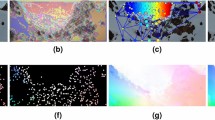Abstract.
Sparse optic flow maps are general enough to obtain useful information about camera motion. Usually, correspondences among features over an image sequence are estimated by radiometric similarity. When the camera moves under known conditions, global geometrical constraints can be introduced in order to obtain a more robust estimation of the optic flow. In this paper, a method is proposed for the computation of a robust sparse optic flow (OF) which integrates the geometrical constraints induced by camera motion to verify the correspondences obtained by radiometric-similarity-based techniques. A raw OF map is estimated by matching features by correlation. The verification of the resulting correspondences is formulated as an optimization problem that is implemented on a Hopfield neural network (HNN). Additional constraints imposed in the energy function permit us to achieve a subpixel accuracy in the image locations of matched features. Convergence of the HNN is reached in a small enough number of iterations to make the proposed method suitable for real-time processing. It is shown that the proposed method is also suitable for identifying independently moving objects in front of a moving vehicle.
Similar content being viewed by others
Author information
Authors and Affiliations
Additional information
Received: 26 December 1995 / Accepted: 20 February 1997
Rights and permissions
About this article
Cite this article
Convertino, G., Stella, E., Branca, A. et al. Optic flow estimation by a Hopfield neural network using geometrical constraints. Machine Vision and Applications 10, 114–122 (1997). https://doi.org/10.1007/s001380050064
Issue Date:
DOI: https://doi.org/10.1007/s001380050064




